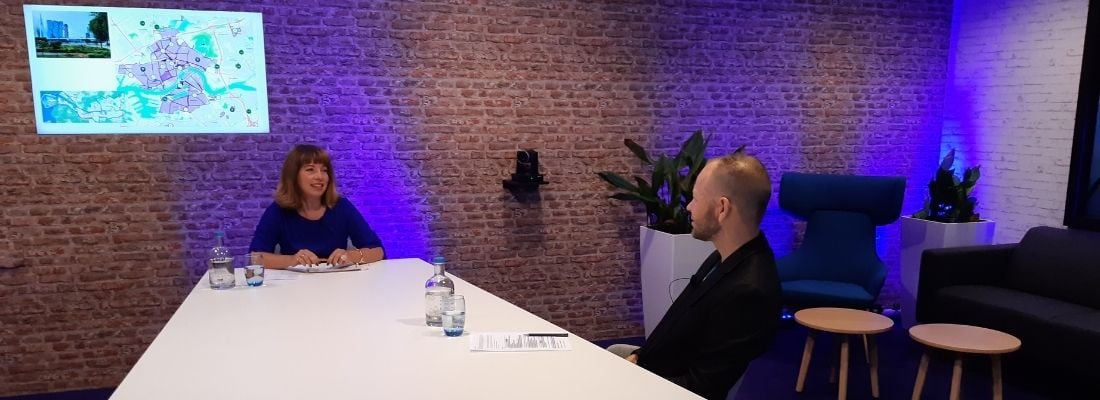Intertraffic ON AIR Episode 3: Parking as a Service

Parking as a Service: Has it come of age?
The parking sector currently faces many urban mobility and climate challenges such as tackling congestion and liveability issues, as well as responding to new health and security requirements brought about by the pandemic. Reducing congestion caused by drivers searching for a parking place, increasing traffic in city centres, getting get rid of fully parked streets, striving for multiple use of urban space and creating customized parking services are at the top of the agenda of many policy makers - so, we asked our expert panel, has Parking as a Service’s time come?
SUMP
Ivo Cré, POLIS’s Director of Policy & Projects, is also Dissemination WP leader of Park4SUMP, an EU project that aims to help cities integrate innovative parking management solutions into Sustainable Urban Mobility Plans (SUMPs) for better mobility and quality of life. Cré explained that the project aims to help partner cities (spread far and wide across Europe, from Trondheim to Shkodra, Albania) to integrate parking management into their (future) SUMP, free up an average of 10% of public space currently used for parking by means of participatory planning and hypothecate at least 10% of parking revenues into sustainable transport, active modes such as walking and cycling and develop more ‘human-centred’ neighbourhoods.
“Park4SUMP aims at stimulating further innovation in parking management and turning parking policies from being reactive and operational to become more strategic, effective and holistic,” he said.
Under the auspices of Park4SUMP, 14 national governments will increase their knowledge of how their state’s legislation on parking facilitates and hinders the use of effective parking management by cities in that state and 300 external follower cities will benefit from capacity building and exploitation of results to improve integration of parking and SUMP policies.
“For many years parking has been neglected.”
As Cré pointed out, an increased awareness of parking services, paired with an equally increased effectiveness of new and existing parking management, has tangible, positive results. As evidenced by Munich, a city that has seen a 25% decrease in overnight parking, a 40% drop in “long-term parking” and a subsequent 75% increase in bike use. These figures are not coincidental.
“For many years parking has been neglected,” Cré opined, “but Park4SUMP is changing that.” He cited parking spaces being higher on the agenda of new building plans as a case in point, and that parking is now being included far more readily in local and national authorities’ intermodal transport thinking.
“Parking measures are very complex - it’s a matter of constantly finding the right balance” said the City of Rotterdam’s Smart Mobility and Parking Advisor, Bastiaan Pigge. Finding that balance is something of a holy grail for Pigge, whose current focus is on relieving high pressure parking areas through the city’s involvement in Park4SUMP.
“Rotterdam already had parking since 1956 and cashless paying since 2001.”
Congestion and parking
With local residents in the city finding parking spaces at a premium (if not impossible to locate) Rotterdam installed sensors on 450 on-street parking spots and encouraged the city’s inhabitants to download an app that displayed the location of free spaces. This had a dual purpose - removing the frustration of not finding a place to park within several hundred yards of their house and reducing congestion in the city centre, up to 60% of which was often residents circling local areas trying to find parking spaces that didn’t exist. However, residents soon stopped using the app and Pigge highlighted the need for joined-up thinking.
“You have to know that you are targeting the right group,” he explained. “And have you given them the right tool?”
Pigge explained that the city set about removing over 2,000 parking spaces with the purpose of encouraging the use of other modes of transport. One such measure was the introduction of parakeets, parking spaces that were removed but repurposed for bikes, or outdoor seating or even turfed over and turned into a public space as a small extension of a local park.
“There’s no need to ban cars per se,” Pigge said. “Rotterdam isn’t ready for that but you can make use of good examples of other cities that have tackled their parking issues in a sensitive way.”
“Now the congestion in Trondheim is caused by electric vehicles.”
A fair percentage of Trondheim’s parking issues also stem from congestion, but the leader of the city’s Lighthouse Project, Bjørn Ove Berthelsen, is convinced that it’s a victim of Norway’s success in promoting the use of electric vehicles. Congestion levels in the city centre have not decreased significantly over the last few years (other than during the pandemic) but what has changed is the make-up of the traffic itself. Now the congestion is caused by electric vehicles, thanks in no small part to Norway’s innovative and extensive incentive scheme from 2012 in which 50% of the cost of a new EV was covered by a first of a kind Government scheme. For several years afterwards EVs comprised the top five new cars list in Norway, with 18% of all cars electric models as of March 2021.
“56% of all passenger cars bought in Norway this year have been electric models, plus 20% of freight vehicles,” Berthelsen said, with Norway still boasting the highest percentage of EVs and charging points in Europe “You could say we’ve become our own enemy!”
Parking as a Service
“Parking as a service can really boost green mobility,” he says, citing eMaaS (electric Mobility as a Service) that must include Parking as a Service as a potentially successful remedy, plus the introduction of a scheme that ensures vehicle sharing schemes’ stock are fairly spread around the city to avoid unnecessarily occupying parking spaces.
Where does parking fit into Trondheim’s mobility thinking? “That is the crucial question,” says Berthelsen or, “rather, the answer to it is.”
“We need to identify an ownership model and we’re a firm believer in public-private partnerships,” he reiterated. “Who owns the opportunity? Plans are needed. A hierarchy is needed and consultation is needed. We need to harness system innovation for parking.”
Berthelsen concluded by reporting that Trondheim is now, together with a number of ’traffic actors’, exploring the possibility of implementing a vehicle-to-grid scheme, similar in principle to Amsterdam’s successful V2G project.
Watch the full episode of Intertraffic ON AIR
In case you registered, you can watch the full episode here.


